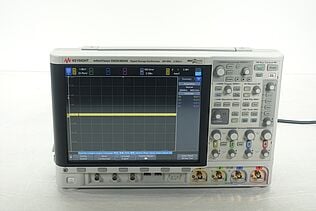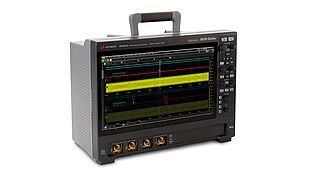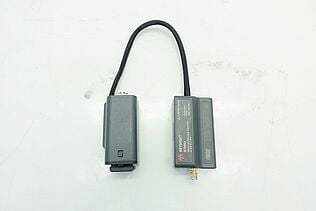- Introduction
- What is Electric Current?
- What is Current Measured in?
- Ampere (A)
- Milliampere (mA)
- How is Electric Current Measured?
- Ammeter
- Multimeter
- Current Probe
- Direct Current (DC) vs. Alternating Current (AC)
- Circuit Theory Basics
- Practical Applications of Measuring Current
- Safety Considerations When Measuring Electric Current
- Beyond the Basics: Advanced Concepts in Electric Current Measurement
- The Importance of Calibration and Error Sources
- Calibration Services and Warranty with Keysight’s Premium Refurbished Equipment
- Conclusion: Empower Your Electrical Expertise
- Whenever You’re Ready, Here Are 5 Ways We Can Help You
As engineers, you want to be at the forefront of your field, creating technologies that make a real difference. But mastering electric current measurement comes with unique challenges.
This guide will make your journey easier by helping you overcome common obstacles, like finding accurate and easy-to-understand resources and applying basic concepts in real-life situations.
We understand the pressure of getting it right. Worrying about a miscalculation leading to a safety issue or system failure is something we all face. In this guide, we'll make sure you're equipped with the knowledge and strategies to overcome any of these obstacles.
Electric current plays a crucial role in everything from your everyday gadgets to massive industrial machines. In this article we’ll discuss what current is measured in and how to nail those measurements every time.
We're here to clear up the confusion, arm you with knowledge, and ensure your projects are safe, cutting-edge, and successful. Let's get started on making your work easier and more impactful.
What is Electric Current?
Electric current represents the rate at which electric charge flows through a conductor, such as a wire. At the heart of this flow are electrons, tiny particles that carry charge through the conductor. These electrons move from one atom to another, creating what we know as electricity.
Interestingly, when we talk about the direction of current, we often refer to "conventional current flow," which is the direction positive charge would move. This means conventional current flows from the positive side of a battery (or power source) to the negative side.
In reality, electrons, which are negatively charged, move in the opposite direction, from negative to positive. This distinction is crucial in understanding electrical principles but doesn't affect the practical use of electricity in our daily lives and technology.
Electric current powers everything from the smallest household gadgets to massive industrial machinery. It serves as the lifeblood of our technological advancements, powering not only computers but also smartphones, lighting systems, and countless other innovations that shape and enhance our daily lives.
Understanding how electric current works is essential not just for engineers and technicians but for anyone looking to grasp the basics of how electronic devices operate.

What is Current Measured in?
Electric current is quantified in amperes (A) and milliamperes (mA), units that are essential for various applications across the field of electronics and electrical engineering. Below is a comparison of these units with examples of their applications.
| Unit | Definition | Application Examples |
| Ampere (A) | The standard unit of electric current in the International System of Units (SI). One ampere is defined as one coulomb of charge passing through a point in a circuit per second. | Household appliances, electric vehicles, and industrial machinery. |
| Milliampere (mA) | A subunit of the ampere, where one ampere equals one thousand milliamperes (1 A = 1000 mA). Useful for measuring small currents | Electronic circuits, LED lights, and portable electronic devices. |
Ampere (A)
The ampere stands as the standard unit of electric current in the International System of Units (SI). It is defined by the flow of one coulomb of charge passing through a specific point in a circuit per second.
This measurement is pivotal in assessing the electrical current's strength in larger applications, such as powering household appliances, electric vehicles, and industrial equipment, where the flow of electric charge is significant.
Milliampere (mA)
The milliampere represents a subunit of the ampere, ideal for measuring smaller currents with precision. One ampere is equivalent to one thousand milliamperes, making the milliampere particularly suited for applications where the electrical current is less intense.
- Electronic circuits: Used in the detailed measurement of current flowing through components like resistors and integrated circuits.
- Small devices: Essential for quantifying the current in battery-powered gadgets such as smartphones, tablets, and other portable electronics.
Understanding these units and their applications is crucial for accurately measuring and managing electric currents across a wide range of electrical and electronic systems.
Secure Precision with Keysight’s Certified Refurbished Equipment
How is Electric Current Measured?
To accurately measure electric current, we use specialized instruments that can quantify the flow of electric charge in a circuit. The most common tools for this task are ammeters, multimeters, and current probes, each offering unique features and advantages for different applications.
| Instrument | Features | Pros | Cons |
| Ammeter | Specifically designed to measure electric current. Requires series connection with the circuit. | High accuracy for current measurements. Simple to use. | Can only measure current. Must interrupt the circuit to connect. |
| Multimeter | Versatile device that can measure voltage, current, and resistance. Switchable modes for different measurements. | Offers multiple functions beyond current measurement. Convenient for various electrical diagnostics. | Less precise than dedicated ammeters for current measurement. May require switching modes and leads for different tests. |
| Current Probe | Clamps around a conductor to measure current without direct contact. Uses magnetic fields to determine current flow. | Non-intrusive measurement. Ideal for measuring currents in difficult-to-reach places or in live circuits. | May be less accurate than direct contact methods. More expensive than basic ammeters. |
Ammeter
An ammeter is an instrument specifically engineered to measure electric current flowing through a circuit. It's the go-to tool when you need to know how much current is passing through a particular part of your electrical system.
Connection Steps
- Step 1: Disconnect power from the circuit before making any connections.
- Step 2: Identify the circuit component you want to measure the current through.
- Step 3: Connect the ammeter in series with this component. This means you need to open the circuit and insert the ammeter so that the current flows through the ammeter.
- Step 4: Ensure the ammeter's positive (+) terminal is connected towards the source of power, and its negative (-) terminal is connected towards the component.
Always make sure the ammeter can handle the expected range of current to avoid damage to the instrument or potential safety hazards.
Multimeter
A multimeter is a versatile and indispensable tool in the field of electronics and electrical engineering. It's designed to measure not just electric current but also voltage and resistance, making it a multifunctional device suitable for a wide range of diagnostic tasks.
Capable of measuring AC (alternating current) and DC (direct current) voltage, current, and resistance. Some advanced models can also measure capacitance, continuity, frequency, and more.
Current Measurement Settings
- Select the correct mode: Ensure the multimeter is set to the current measurement mode. For DC current, look for a setting marked with "A" and a straight line; for AC current, look for "A" with a wave symbol.
- Choose the right range: If your multimeter requires manual range selection, choose a range that's higher than the expected current. If uncertain, start with the highest range and step down to avoid damaging the multimeter.
Using a multimeter requires proper understanding and handling, especially when measuring current, as this often involves breaking the circuit to insert the meter in series with the load. Always ensure the multimeter is properly configured for the type of measurement you're conducting to ensure accuracy and safety.

Current Probe
A current probe is a specialized device designed for measuring electric current without the need to make direct electrical contact with the conductor. Unlike ammeters and multimeters, which require integration into the circuit, current probes can measure current flow non-intrusively, making them an ideal choice for certain applications.
- Non-intrusive measurement: Current probes use magnetic fields generated by electric currents to measure the flow of current. This allows for safe and quick measurements without disconnecting parts of the circuit.
- High-current situations: They are particularly useful for measuring high currents that would be dangerous or impractical to measure with direct contact methods. This capability makes current probes essential in industrial applications where safety and efficiency are paramount.
Types of Current Probes Suitable for Current Measurement
- Clamp meters: Feature a clamp that can be opened and placed around a conductor to measure the current without physical contact. Ideal for quick diagnostics in electrical panels and systems.
- Rogowski coils: Flexible coils that can be wrapped around conductors of various sizes, useful for measuring alternating currents in tight or difficult-to-reach spaces.
- Hall effect sensors: Utilize the Hall effect principle to measure both AC and DC currents. These sensors can be found in both clamp-on designs and as part of more complex measurement systems for detailed analysis.
Current probes provide a versatile and safe way to measure electric currents, especially in situations where traditional direct contact methods are not feasible or safe. They are an invaluable tool for engineers and technicians working in a wide range of electrical and electronic applications.
Direct Current (DC) vs. Alternating Current (AC)
Understanding the differences between Direct Current (DC) and Alternating Current (AC) is fundamental for anyone involved in electrical engineering or working with electrical systems. DC and AC are two types of electrical current that power our world, each with its unique characteristics, advantages, and applications.
- Direct Current (DC): DC is a type of electric current that flows in one direction. It is commonly used in electronic devices, like smartphones and laptops, because it provides a stable voltage level. DC is simple and reliable, making it ideal for sensitive electronic circuits. However, AC is more efficient than DC for transferring power over long distances due to lower energy losses.
- Alternating Current (AC): AC changes direction periodically. This type of current is used for household and industrial power supply because it can be easily transformed to different voltages, reducing power loss over long distances. AC's main advantage lies in its ability to be transmitted over long distances with less loss, which makes it more efficient for the power grid. Typical applications include powering homes, offices, and factories.
When measuring current, it's crucial to understand whether you're dealing with DC or AC, as this influences the choice of measurement tools and techniques.
- For DC measurements, a multimeter set to the DC setting provides accurate current readings. Direct contact with the circuit is necessary, either by inserting an ammeter in series or using a clamp meter that can measure DC currents.
- For AC measurements, a clamp meter is often used for its ability to measure current non-intrusively. Multimeters can also measure AC current with accurate selection of the AC setting, phase, and waveform.
Understanding whether an application uses DC or AC is essential for selecting the correct measurement technique, ensuring safety, and achieving accurate and reliable results.
Circuit Theory Basics
At the heart of electrical engineering lies the foundational principle known as Ohm's Law, which explains the intricate relationship between current (I), voltage (V), and resistance (R) in an electrical circuit.
Ohm's Law states that the current flowing through a conductor between two points is directly proportional to the voltage across the two points and inversely proportional to the resistance between them. This relationship is elegantly summarized by the equation I= V/R, where I is the current measured in amperes (A), V is the voltage measured in volts (V), and R is the resistance measured in ohms (Ω).
Understanding this fundamental interplay is crucial for effectively measuring and managing electric current in any application. It allows engineers and technicians to predict how changing one element affects the others, facilitating the design, analysis, and troubleshooting of electrical circuits.
For instance, knowing the voltage across a component and its resistance enables one to calculate the current flowing through it, an essential skill in both theoretical and practical aspects of electrical engineering.
Mastering the basics of circuit theory, especially the principles outlined by Ohm's Law, is indispensable for accurate current measurement. It not only aids in the proper selection and application of measurement tools but also ensures the safety and efficiency of electrical systems.
Practical Applications of Measuring Current
Measuring electric current plays a pivotal role across a wide array of applications, from designing intricate electrical circuits to ensuring the efficiency and safety of renewable energy systems and consumer electronics.
Accurate current measurement is not just a fundamental task in electrical engineering; it's essential for troubleshooting issues, optimizing system performance, and enhancing the reliability of electrical and electronic devices.
Electrical Engineering
Engineers rely on precise current measurements to verify that components operate within their intended specifications.
This is particularly important in the development of power supplies, where the stability of output current directly impacts the performance and reliability of electronic devices.
Accurate current measurement allows engineers to identify potential overloads or inefficiencies in circuits, facilitating timely adjustments that prevent damage and improve efficiency.
Renewable Energy Systems
As the world shifts towards sustainable energy solutions, the importance of measuring current in renewable energy systems, such as solar panels and wind turbines, cannot be overstated.
Here, current measurement is vital for monitoring the output and efficiency of these systems. For instance, in solar power systems, measuring the current generated by photovoltaic cells helps in assessing the system's performance and optimizing energy production.
Similarly, in wind turbines, current measurements ensure that the generated power is within safe and optimal levels for both storage and distribution to the grid.
Consumer Electronics
In the realm of consumer electronics, from smartphones to laptops, accurate current measurement ensures the safety, efficiency, and longevity of these devices.
By measuring the current flowing through batteries and charging circuits, manufacturers can optimize charging algorithms, prevent overcharging, and enhance battery life. Current measurement also helps in the design of energy-efficient devices, reducing power consumption without compromising performance.
Troubleshooting and System Optimization
Beyond design and production, accurate current measurement is indispensable for troubleshooting and system optimization. It allows technicians to pinpoint faults in circuits, such as short circuits or component failures, by identifying unexpected current flows.
In industrial settings, monitoring the current consumption of motors and other heavy machinery can signal the need for maintenance, thereby preventing costly downtime and extending equipment lifespan.
The practical applications of measuring current extend far beyond the confines of traditional electrical engineering. From powering innovation in renewable energy to enhancing the user experience in consumer electronics, the ability to measure current accurately is foundational to the advancement and reliability of modern technology.
Safety Considerations When Measuring Electric Current
Safety is paramount when measuring electric current, as mishandling electrical devices and circuits can lead to serious injuries or even fatalities. Understanding and adhering to safety guidelines is crucial to prevent electrical hazards and ensure a safe working environment.
Here are some key safety considerations and practices to follow when measuring electric current.
- Understand the equipment: Before using any equipment to measure current, thoroughly understand its operation, range capabilities, and safety features. Ensure the device is suitable for the specific type of current (AC or DC) and the expected range of measurements.
- Use of protective equipment: Always wear appropriate personal protective equipment (PPE). This includes insulated gloves, safety glasses, and, in some cases, flame-resistant clothing. These protective measures minimize the risk of electric shock and other injuries.
- Verify equipment integrity: Regularly inspect measurement tools for any signs of damage or wear, such as frayed wires, cracked casings, or damaged probes. Using compromised equipment can lead to inaccurate measurements and pose significant safety risks.
- De-energize circuits when possible: Whenever feasible, de-energize the circuit before connecting measuring instruments. If it's necessary to measure current in a live circuit, ensure you have a clear understanding of the circuit's behavior and the potential risks involved.
- Follow correct measurement procedures: Always connect ammeters in series with the circuit to measure current accurately without causing a short circuit. For non-contact measurements, such as those using a clamp meter, ensure the device is correctly positioned around the conductor without making direct contact.
- Avoid working alone: When possible, avoid working alone on electrical measurements, especially in environments with high voltages or currents. Having someone nearby can provide immediate assistance in case of an emergency.
By following these safety guidelines, you can significantly reduce the risk of electrical hazards when measuring electric current.
Beyond the Basics: Advanced Concepts in Electric Current Measurement
Going deeper into electric current measurement uncovers many advanced topics that cater to specialized applications requiring high precision and non-invasive techniques. These advanced concepts not only enhance the accuracy of measurements but also open doors to innovative applications in various fields. Here are several key areas worth exploring.
Measuring Transient Currents
Transient currents are temporary, often very brief, changes in current flow resulting from switching actions, faults, or other disturbances in electrical systems.
Capturing these fast, transient events requires specialized equipment, such as high-speed oscilloscopes and current probes capable of detecting rapid changes.
Understanding transient currents is crucial for the design and protection of power systems, as well as for troubleshooting faults and ensuring the reliability of electronic devices.
Precision Current Measurement Techniques
For applications where even slight inaccuracies can have significant consequences, precision current measurement techniques come into play.
These include the use of high-precision shunt resistors, zero-flux current transformers, and digital sampling methods.
Such techniques are essential in laboratories, calibration services, and industries where precise control of current is necessary for the validation of experimental results or the production of high-quality products.
Non-Invasive Sensors for Current Measurement
Non-invasive measurement methods, such as clamp-on current transformers and Hall effect sensors, allow current to be measured without direct contact with the conductor or interruption of the circuit.
These methods are invaluable for monitoring power consumption, detecting anomalies in electrical installations, and facilitating maintenance and diagnostics in live systems without compromising safety or system operation.
The significance of these advanced measurement methods lies in their ability to provide accurate, reliable data in scenarios where traditional measurement techniques may fall short.
Whether it's improving the functionality of power grids, laboratory instruments, or industrial processes, these advanced concepts significantly contribute to the progress of electrical and electronic engineering.
The Importance of Calibration and Error Sources
Calibration of measuring instruments is crucial to ensure the accuracy and reliability of electric current measurements.
Regular calibration against known standards helps identify and correct any deviations in instrument readings, ensuring that measurements remain precise and trustworthy over time.
This process is vital for maintaining the integrity of electrical work, from basic troubleshooting to advanced research and development.
Common Sources of Error in Current Measurement
- Lead and connector resistance: Can introduce significant errors in low-current measurements. Minimize by using low-resistance connections and four-wire (Kelvin) measurement techniques.
- Temperature variations: Can affect the accuracy of components and instruments. Use temperature-compensated devices and conduct measurements in controlled environments.
- Electromagnetic Interference (EMI): External electrical noise can distort measurements. Reduce EMI by using shielded cables and conducting measurements in electromagnetically quiet environments.

Calibration Services and Warranty with Keysight’s Premium Refurbished Equipment
Keysight's refurbished equipment provides a cost-effective option for obtaining high-quality measurement tools that have been rigorously calibrated. This guarantees that the instruments meet or exceed original performance specifications.
Keysight provides a like-new warranty with their refurbished equipment, offering peace of mind and support for any issues that may arise. This demonstrates Keysight's dedication to providing high-quality refurbished equipment that professionals can rely on for accurate current measurement capabilities.
Meet local and global requirements with 18 local accreditation bodies, including ANAB, UKAS, CNAS, and JCSS. Need a particular ISO or ANSI metrology standard, such as ISO / IEC 17025.
“For all used equipment, we offer clients calibration and 1-year warranty.” – Keysight Account Manager
Maximize Your Measurement Capabilities with Keysight’s Calibration Services
Did you know? All your premium used equipment comes calibrated just like new equipment. Same belt. Same quality.
Select up to 3 instruments to compare
Enable Notifications
In order to use this feature, you need to enable notifications.
Manage notification preferences
Conclusion: Empower Your Electrical Expertise
From the outset, we outlined the journey to mastering electric current measurement, highlighting the hurdles such as finding the right balance between theory and practical application, and the need for precision in real-world scenarios.
We’ve covered everything from the basics of what electric current is to the tools you need to measure it. We also looked at why measuring current accurately matters in real-world applications and how staying safe while doing it is non-negotiable.
The takeaway? Knowing how to measure electric current is key for anyone serious about electrical systems and engineering.
It's all about building your knowledge, keeping things safe, and making sure whatever you're working on runs smoothly and efficiently. And with Keysight you can tackle the future of electrical work head-on.
Think of every measurement you make as one more step towards achieving your goals. This isn't just about getting the hang of the basics; it’s about gearing up with the know-how to confidently tackle future challenges. Let’s keep pushing the envelope, armed with the insight and tools to make our mark.
Whenever You’re Ready, Here Are 5 Ways We Can Help You
- Browse our premium used network analyzers, oscilloscopes, signal analyzers and waveform generators.
- Call tech support US: +1 800 829-4444
Press #, then 2. Hours: 7 am – 5 pm MT, Mon– Fri - Talk to our sales support team by clicking the icon (bottom right corner) on every offer page
- Create an account to get price alerts and access to exclusive waitlists.
- Talk to your account manager about your specific needs.






































































